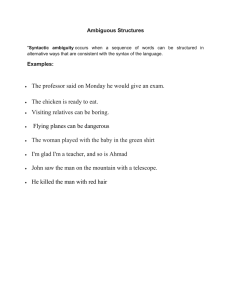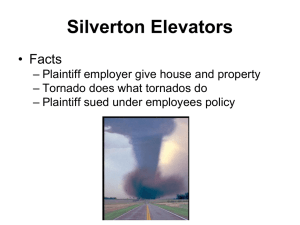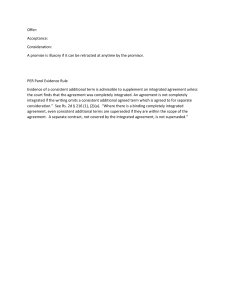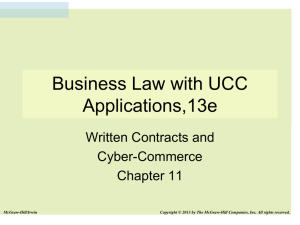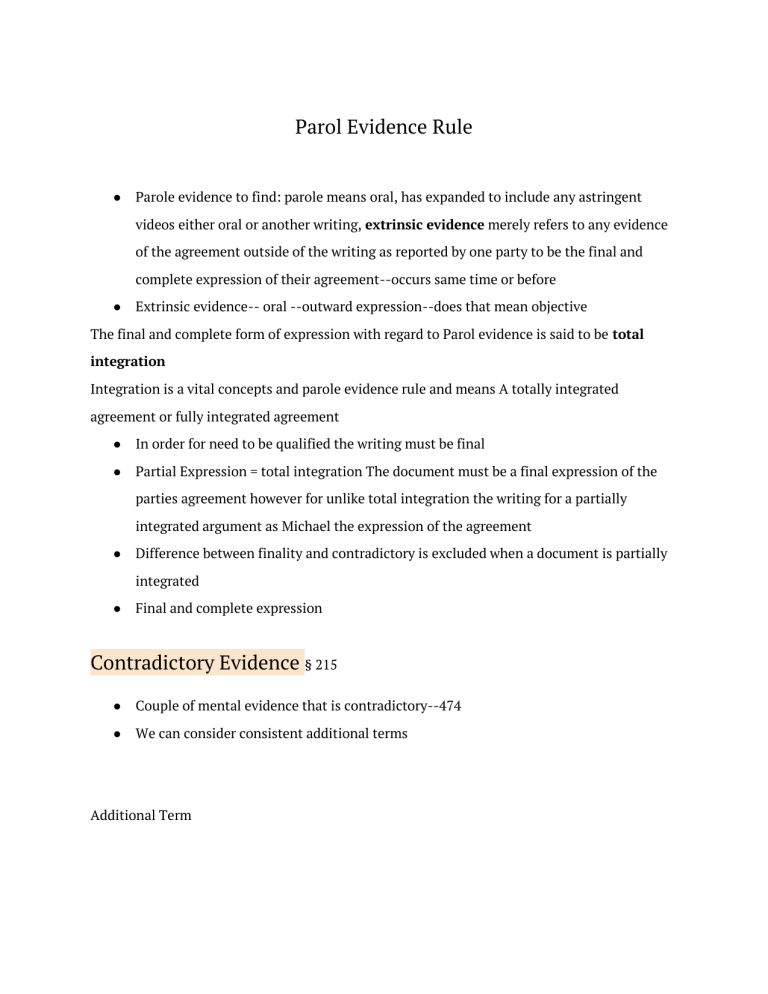
Parol Evidence Rule ● Parole evidence to find: parole means oral, has expanded to include any astringent videos either oral or another writing, extrinsic evidence merely refers to any evidence of the agreement outside of the writing as reported by one party to be the final and complete expression of their agreement--occurs same time or before ● Extrinsic evidence-- oral --outward expression--does that mean objective The final and complete form of expression with regard to Parol evidence is said to be total integration Integration is a vital concepts and parole evidence rule and means A totally integrated agreement or fully integrated agreement ● In order for need to be qualified the writing must be final ● Partial Expression = total integration The document must be a final expression of the parties agreement however for unlike total integration the writing for a partially integrated argument as Michael the expression of the agreement ● Difference between finality and contradictory is excluded when a document is partially integrated ● Final and complete expression Contradictory Evidence § 215 ● Couple of mental evidence that is contradictory--474 ● We can consider consistent additional terms Additional Term Analytical framework From Lecture Issue spotting; not every branch of contract limit involves the application of parole evidence it’s possible that the parties agree that the writing reflects entire agreement and alternatively the agreement might be entirely oral which means the parol evidence rule is not an issue the Parole Atlanta broooo The Companies from the following three scenarios 1) two or more parties enter into a contract and there is a writing that evidence of the contract exist— §29–33– 24 2) When a party inferrs there is more to the agreement then it is a parole evidence issue 3) If they are asking if we should consider external evidence then parole Classic Rule (Williston View): plain meaning rule “four corners rule” --not from extrinsic evidence Modern Rule (Corbin Rule): judge may consider all the surrounding facts and circumstances to determining whether a writing is integrated Merger Clause (Integration Clause) Merger Clause tells the judge that the document is totally integrated Understanding the Framework for Integration 1. Determining Integration: This entails asking if the writing is TOTALLY integrated 2. Admissibility of Evidence: what type of evidence is being introduced --is it Contradictory or a Consistent Additional term? §216 Defines Consistent Additional Terms: 1) Evidence of a consistent additional term ● is admissible to supplement an integrated agreement UNLESS the Court determines the agreement was completely integrated 2) An agreement is not completely integrated if the writing doesn't have a consistent additional term ➔ Examples of the previous scenario are a)agreed to for separate consideration, or b) such a term as in the circumstances might naturally be omitted from the writing ➔ Courts deciding on whether the agreement is completely integrated based on relevant evidence → including the evidence of consistent additional terms ➔ Terms to the agreement are superseded to the extent that they are th ● Classic jurisdiction: if Writing appears to be what complete and I ambiguous mean cemetery can only be determined what colors are riding in the from extrinsic evidence→ the presence of merger clause is positive and green with a murder closet automatically considered totally integrated classic jurisdiction Contradictory Terms Consistent Additional Terms Total Integration Not Admissible Not Admissible Partial Not Admissible Admissible No Integration Admissible Admissible Parol Evidence Rule Exceptions The parol evidence rule does not bar the introduction: a) Evidence offered to interpret the ambiguous term b) Subsequent agreements ● Exceptions to the rule: The exceptions apply regardless of the type of jurisdiction, classic or modern, the level of integration, partial or total, or the type of evidence, conflicting or a consistent additional term Types of Exceptions A) evidence offered to interpret an ambiguous term: the issue with this arises in classic jurisdiction because it is an extrinsic evidence matter when discussing ambiguity B) Subsequent agreements (oral or written): merger clause tends to include language that prohibits oral modifications to the agreement a.k.a. no oral modification clauses courts in modern jurisdiction have routinely refused to enforce no oral modification clauses for the same reason they dismiss the merger clause when allowing parole evidence to be introduced → No oral Modification is often a boilerplate term C) Showing of fraud, mistake, Darius, undue influence, or other void ability: extrinsic evidence is admissible if it shows that one party has a difference such as the ones listed above or if there is some other factor that makes the contract void such as lack of agreement during the bargaining process or lack of consideration D) Collateral agreements with separate considerations: equilateral contract is one in which the parties agreed to Enter into a second related ( i.e. collateral )contract for separate consideration→ collateral agreements are typically the most important to the overall transaction and must be independent of the primary contract in terms of meeting all formation requirements of a contract and a separate consideration E) Condition Precedent to the formation of a contract: there are some scenarios in which parties drafted a written agreement that is totally integrated; however, they have also agreed (orally or in a different writing) but there is a condition i.e. some event that must occur before the fully integrated agreement takes effect in these scenarios the evidence of condition is admitted in order to prove that the condition never occurred in that the contract is ineffective think of conditional contracts Parol Evidence Rule UCC section 2–202 : Terms with respect to confirmatory memo of the parties agree or which are otherwise set forth in writing intended by the parties as a final expression of their agreement with respect to search terms are included there in may not be contradicted by evidence of any prior agreement or of contemporaneous oral agreement but may be explained or supplemented A) Bicors of dealing or usage of trade or by course of performance; & B) Buy evidence of consistent additional terms unless the court fines the writing to of been intended also as a complete an exclusive statement of the terms of the agreement Gianni V. R. Russell and Co. IMC. ● Disputed terms of the transaction: The plaintive set up a bargain and wedge in consideration of his promise not to sell tobacco and to pay an increased rent and for entering into their agreement as a home he should have exclusive right to sell salt drinks in the building —this stipulation was not in the written lease— plaintive brought this action for damages for breach of alleged oral contract it was permitted to recover the defendant appealed ● Where does the court discuss parole evidence rule and what test is used to determine if the oral agreement should have been included in the writing? Page 488 ● How does the court rationalize the oral evidence should not be admissible RULE: Where parties, without any fraud or mistake, have deliberately put their engagements in writing, the law declares the writing to be not only the best, but the only, evidence of their agreement. All preliminary negotiations, conversations and verbal agreements are merged in and superseded by the subsequent written contract and unless fraud, accident or mistake be averred, the writing constitutes the agreement between the parties, and its terms cannot be added to nor subtracted from by parol evidence. FACTS: Plaintiff lessee ran a store inside of an office building. Defendant lessor acquired the property, and after its agent negotiated with the plaintiff, a lease for three years was signed containing a provision that the plaintiff should use the premises only for the sale of fruit, candy, soda water, etc., with the further stipulation that the plaintiff was not allowed to sell tobacco in any form. Plaintiff alleged that it was agreed that, in consideration of his promises not to sell tobacco and to pay an increased rent and for entering into the agreement, he would have the exclusive right to sell soft drinks in the building. No such stipulation was contained in the written lease. Defendant leased the adjoining room in the building to a drug company without restricting the latter's right to sell soda water and soft drinks. Plaintiff filed a suit for breach of the alleged oral contract. The trial court awarded plaintiff lessee damages. On review, the court reversed judgment. ISSUE: Was the written contract complete in itself and did it preclude any alleged oral agreements from being enforced? ANSWER: Yes. CONCLUSION: The court held that, because the written lease was the complete contract of the parties and it embraced the field of the alleged oral contract, evidence of the oral contract was inadmissible under the parol evidence rule Harold S. Lee V. Joseph E. Seagram and Sons, Inc. ● Terms of the transaction: ● How does the core articulate the parol evidence rule? ● Is this classic or modern jurisdiction? this is classic jurisdiction they cited a case from 1934 when discussing the parol evidence rule (491) ● Decision: the rule did not bar proof of the oral agreement ● The court held if the written contract was not a complete integration in the parol evidence rule has no application page 491 ● The court is determining whether the party intended Ch 22 Interpreting Ambiguous Terms ● Analytical framework for interpreting ambiguous terms is the following: 1) identifying interpretation issues: The courts will determine whether the parties have a dispute over the meaning of a term or a contract as a whole, and whether the term or contract is ambiguous 2) Apply the primary rules of interpretation 3) If needed apply the secondary rules of interpretation ● Disagreements over the express terms of the agreement ● Disagreements over the performance of a party’s duty ● Disagreement over the interpretation of a term Is the term or contract ambiguous? ● Determine whether ambiguity exists— if language is clear in certain courts will enforce the contract ● Courts use the tools of interpretation to determine ambiguity —> there is a jurisdictional split as to how to determine whether ambiguity exist similar to Parol rule ● Classic jurisdiction with ambiguity: ambiguity must exist in the contract language i.e. within the four in corners of the document ● The modern jurisdiction allows the court to consider extrinsic evidence in determining whether an ambiguity exists ● Patent versus latent ambiguities ● Patent ambiguity: language where the plane meaning of the language is uncertain or a reasonably susceptible to more than one meaning ● Latent ambiguity: requires additional outside evidence other than the plain meaning of the term in order to understand that determines susceptible to more than one meaning ● Classic jurisdiction: only considers the plain meaning ● Consider both Patton in Layton ambiguities ● Reasonable susceptibility test: Is the Contract language reasonably susceptible To the reason being asserted ● UCC definition of trade usage/custom: Any practice or method of dealing having such regularity of observance in a place, vacation or trade us to justify an exception that will be observed with respect to the transaction in question ● Customary practices may differ not only by industry table by geography or the relation of the bodies it is not necessary does I was a ambiguity exist in a contract in order to apply a trade usage ● Trade usage as technical definitions: one trade usage to find the meaning of a technical term then it can carry more weight Frigaliment Co. V. B.N.S International Sales Corp RULE: When one of the parties is not a member of the trade or other circle, his acceptance of the standard must be made to appear by proving either that he had actual knowledge of the usage or that the usage is so generally known in the community that his actual individual knowledge of it may be inferred. FACTS: Defendant state sales corporation had two contracts with plaintiff foreign corporation for the sale of "chicken". After plaintiff received one shipment of stewing chicken and another was stopped, plaintiff brought a breach of warranty action, alleging that the goods sold should have corresponded to the description because the chicken was not suitable for broiling and frying. Plaintiff says 'chicken' means a young chicken, suitable for broiling and frying. ISSUE: Does chicken mean only "young chicken" under the contract?--trade usage definition ANSWER: No. CONCLUSION: In dismissing plaintiff's complaint, district court held that plaintiff's reliance on the fact that the contract forms contained words with a blank not filled to negate agency was wholly unpersuasive where the clause's purpose was to permit filling in an intermediary's name to whom commission would be payable. Defendant's subjective intent that it could comply with the contracts by delivering stewing chicken coincided with objective meaning of "chicken," which had at least some usage in the trade; and plaintiff did not sustain its burden that "chicken" was used in the narrower rather than in the broader sense.
